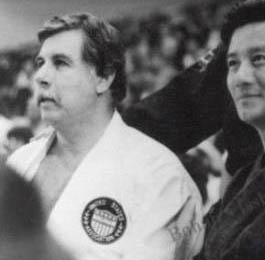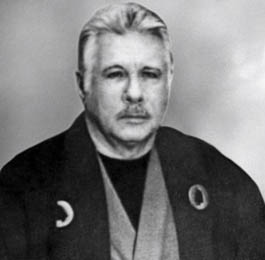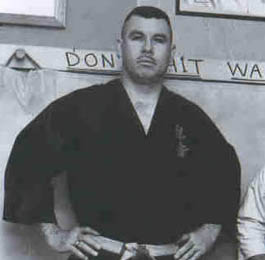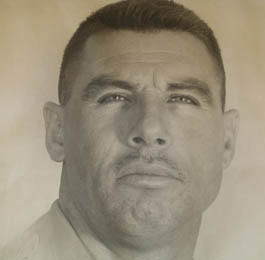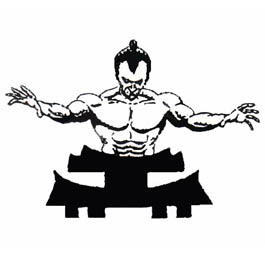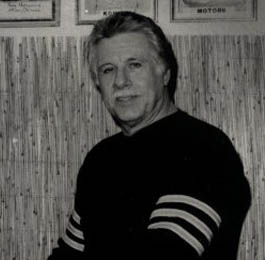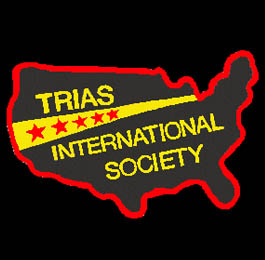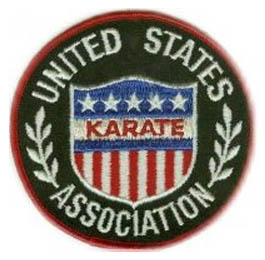About Trias
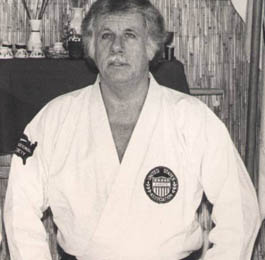
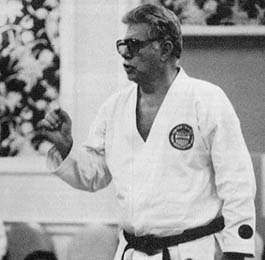
Robert Trias
GRANDMASTER
Grandmaster Robert A. Trias March 18, 1923 - July 11, 1989
Grandmaster Robert A. Trias was a pioneer in the martial arts field. Robert A. Trias was the Grandmaster of the style of Okinawan Shuri Ryu karate. His name is connected with many first in the martial arts world. While Mr. Trias was in the navy during WW II he met a man named T’ung Gee Hsing. This gentleman was watching Mr. Trias in a boxing match and was interested by American boxing. He asked Mr. Trias if he would be interested in learning Hsing-yi in exchange for lessons in American boxing. That was the day that changes history in the martial arts world. Returning home from the war, Trias brought with him his newfound love of the martial arts. In 1945 Trias opened the very fist martial arts school in the United States in Phoenix, Arizona. This accomplishment earned him the title of “Father of American Karate”. Another accomplishment was being the founder of the United States Karate Association, (USKA), one of the largest and oldest martial arts organization in the world. With approximately 500 affiliated schools throughout the world the USKA connected different styles of martial arts together. Furthermore, in 1955 Trias was to conduct the first United States karate tournament. Also he formulated the first set of rules to be used at karate competitions. To this day the basis of his rules are still being used. Without Grandmaster Trias sacrifice and determination the martial arts would not be where they are now. Trias brought to the United States a totally and unheard of art that always carried a certain mystery with it. He managed to insure the spread throughout the nation. His monumental achievement has earned him the respect and gratitude of thousands of martial art disciples throughout the world.
Robert Trias was responsible for the following accomplishments in developing karate in United States:
1955 - Wrote the first rules for karate competition.
1955 - Conducted the first karate tournament.
1958 - Wrote the first textbook.
1959 - Made the first instructional film.
1963 - Conducted the first world karate championships.
1968 - Conducted the first professional karate tournament.
- Published: Karate is my Life, The Hand is my Sword, The Pinnacle
of Karate, The Supreme Way, and Render Yourself Empty. - Recipient of the 1989 Black Belt Hall of Fame Honorary Award.
- 1948 he founded the United States Karate Association (USKA)
- Founded the first karate school in the mainland United States.
Trias Maxim
Karate knowledge is acquired through good health, spiritual and mental perfection and enjoyment of life to its fullest with devotion to God, country, and fellow man.
Karate knowledge shall never be given on the basis of physical performance alone, no matter how excellent the ability.
Karate knowledge shall only be given to those whose moral character can thoroughly be trusted
Robert A. Trias... Opened the first Karate dojo in the the United States in Phoenix, Arizona.
-
Grandmaster Robert Trias recieved his 10th Dan certificate from Grandmaster Makoto Gima on July 10, 1983.
-
Grandmaster Trias
Robert Trias 1989 Black Belt Honorary Award
In a world of fly-by-night martial arts masters, where every Tom, Dick, and Chang claimed to be the father of this style or the grandmaster of that art, Robert Trias was an exception. He was not universally-loved, but whatever the many opinions about the man were, one fact remains: Robert Trias perhaps did more for the martial arts in the United States than any man ever, including Bruce Lee.
Trias' long career began when he was a boxing champion in the U.S. Navy while stationed in the British Solomon Islands during World War 11. During that tour of duty, he learned the rare Chinese art of fusing-i chuan from kung fu master Tung Gee Hsing. That knowledge led to his quest to learn other martial arts. Trias traveled to China, Japan, Okinawa, Hawaii, and other locations, training with the likes of James Mitose and Yasuhiro Konishi, acquiring expertise in shuri and shorei-ryu karate, kempo, ju-jitsu and judo. He would later become style head of shuri-ryu karate, the world's recognized top authority on that art.
Trias then returned to Phoenix in 1946, where he opened one of the first karate schools in America, and immediately became the font of knowledge for a nation of aspiring karateka. A few years later, he began the United States Karate Association (USKA), with the intent of disseminating knowledge about the martial arts to the public, organizing the nation's martial artists into a cohesive, powerful body, and carrying the sport to financial health. Today, the USKA claims more than a half-million members worldwide. Through his teaching, Trias carried the message of the martial arts to millions more across the globe, organizing tournaments, giving seminars, striving tirelessly to communicate karate's ideas of honor, discipline, and respect to new generations. "My purpose is to make the practitioner aware of the changes in karate, from the karate of the past to the karate of today," Trias said in one of his many prepared public statements.
Unfortunately, he never saw all his goals realized. Trias was diagnosed with bone cancer in 1987, and his body weakened as the disease spread. Nonetheless, he continued to teach and give seminars as long as his failing health would allow. Some students spoke of caring for Trias before seminars, giving him shots of morphine to help control his agony during demonstrations which he refused to cancel. On July 11, 1989, Robert Trias courageous struggle ended as he passed away in a Phoenix hospital at age 67. Since then, efforts to replace him as head of the USKA have been acrimonious and confusing. However, as unpleasant as the USKA power struggle has been, the infighting and propaganda have not dimmed the image of a great karate pioneer. Though his organization is in some turmoil, Trias' USKA remains strong and popular, and the memory of the man is that of a great master, teacher, and innovator. The late Robert Trias, a father of the martial arts in America, is unquestionably a worthy recipient of the 1989 Black Belt Hall of Fame Honorary Award.
Dissertation OnThe Origins and Development of Shuri Ryu
One of the brightest stars in the firmament of Oriental thought and culture was the Indian Buddhist monk Bodhidharma. Twenty-eighth in a direct succession from Gautama, he was known by several names, such as the White Buddha; to the Chinese as Ta-Mo; to the Japanese as Taishi Daruma; and to centuries of Zen literature as the first Patriarch. In 500 A.D. Ta-Mo journeyed to the temple of Shorin-ji (Shaolin) situated in Sung Shang, in the province of Honan, where he found the monks physically and mentally unable to endure the discipline required by his teachings. This condition was corrected when Ta-Mo created eighteen exercises called I-chin-ching, which were grouped under a form of Chinese Yoga of Taoist origin. The exercises employed slow motion movements for the cultivation of _chi_ with the subsequent harmonizing of the body and mind. Chi (intrinsic energy; _Ki_ in Japanese) is cultivated without conscious effort or conscious breath, and dwells on the exhalation and inhalation of the soft over the hard and hard over the soft.
By astute observation, it was noticed that all wild creatures are provided with certain natural weapons. These were used for striking, clawing or snapping, with the uncanny ability to retain perfect balance when attacking or defending themselves. For example, the eagle and crane beak employed quick snapping movements; the leopard and tiger claw were associated with quick, powerful clawing movements; and the dragon's slow but powerful crushing movements were observed; as well as many others. The stances of the various creatures were then emulated for the purpose of retaining a natural balance; and man's natural weapons, mainly the hands and thumbs, were fashioned by vigorous training to simulate the beak, claws, talons, etc. of animals and birds. Other methods developed the limbs, hands and feet to substitute for club, dagger, spear, and other weapons. The consolidation of slow breathing exercise forms with the various forms which were copied freely from nature resulted in the 170 forms which became the basis of the Shaolin (Sil-lum) system. During the Yuan dynasty (1279-1368 A.D.) the 18 forms of Taishi Daruma called I-chin-ching were consolidated and this resulted in the formation of 72 body and fist forms. These animal body and fist forms are dominant within the Okinawan Shuri-ryu system.
It is believed that King Sho Tai of Okinawa sent Hohan (Sokon) Matsumura (1806- 1895), Master of Shuri-te and martial arts weapons, to China to increase his knowledge of the Chinese arts. Upon his return, he was appointed personal bodyguard to the king. Matsumura brought back invaluable techniques and methods from the Chuan-fa and Hsing-yi (hsing-i) systems, which at that time were the foremost accepted forms of the Chinese art in China. Shuri-te was the original style of the Okinawan masters Sokon Matsumura, Yasutsune (Ankoh) Itosu; and later Choki Motobu, Kentsu Yabu, Chosun Chibana, Chotoku Kyan, Kanken Toyama, Yasuhiro Konishi, and others.
Through the decade of 1874-1884 traveling monks were being robbed and killed between Canton, Namoi and Tong-king, by roving bands of robbers and cutthroats. Many of these were Chinese rebels or ex-rebels who had been driven across the frontier during the suppression of the Yu-Nan and Taiping rebellions. At the Hai Chiwang Sze Temple, Shang Tsao-Hsiang (Tsao Hsing) had studied the internal systems of Chuan-fa, Hsing-Yi and Pakua, and the external systems of Shaolin-chun and Hung-kun, from the most formidable fighters of that time, Masters Li T'sun Yi (1849-1924) and Sun Lu T'ang (1859-1932). He taught these skills to the monks to enable them to defend themselves against the highway robbers and cutthroats. The elder Hsiang died, leaving to his nephew/son T'ung Gee Hsing (Tong Gee Hsing or Hsiang) the secrets of Hsing-yi. Hsing later settled in the Chinese settlement of Kume Mura in Okinawa.
While Master Hsing lived in Kume Mura, he met Master Choki Motobu. The incorporation of their two noble systems became the basis of modern Okinawan Shuri-te and the entirety of the Shuri-ryu system as taught today. Shuri-ryu's insistent standard is in the extensive use of bone strength. The body alignment of bone power must be present, with three or more points of muscular bone balance meeting in a direct line with the center of gravity of the body before the execution of any block or strike. Strikes are essentially circular, and the power of the opponent is also deflected in a circular motion. The system employs seventy-five percent use of hands and twenty-five percent use of feet. It is best recognized by its low Chinese horse stance (Kiba-Dachi) and the exaggerated swivel of the hips with a coil-like spring action of the body when striking. It stresses the strength of the dragon, the bone strength of the tiger, the inner and outer strength of the leopard, the hidden or spiritual strength of the crane, and the lower abdominal breath strength and power of the snake or serpent.
External breath control, with body movements incorporating animal body and fist forms, is essential before the execution of any strike. The body and limbs harden (harmonizing soft and hard) at the exact time of contact (maximum exertion), instantaneously stopping at a given point with a loud kiai. The body again becomes soft until the next strike. Three levels of blocking and striking in conjunction with three degrees of tightness and muscle tension are utilized in practice. There are seven attacking and retreating methods (Kogeki) which are used in conjunction with eight distinctive types of attacks which can be executed in a circular fashion or a "V" formation. The reactionary striking manner, symbolic in the snake or crane, is strictly enforced in the system. When the user blocks any movements, he must react spontaneously with a quick whiplike strike. Shuri-ryu is a very old and traditional system with a long and unbroken history. From the ancient method, much wisdom has been gained and recorded. Shuri-ryu is a totally complete system, and from it have come many other systems. It stresses a synthesis of Eastern and Western attitudes toward life, and through its practice and philosophy, a great inner peace and freedom will be reached.

